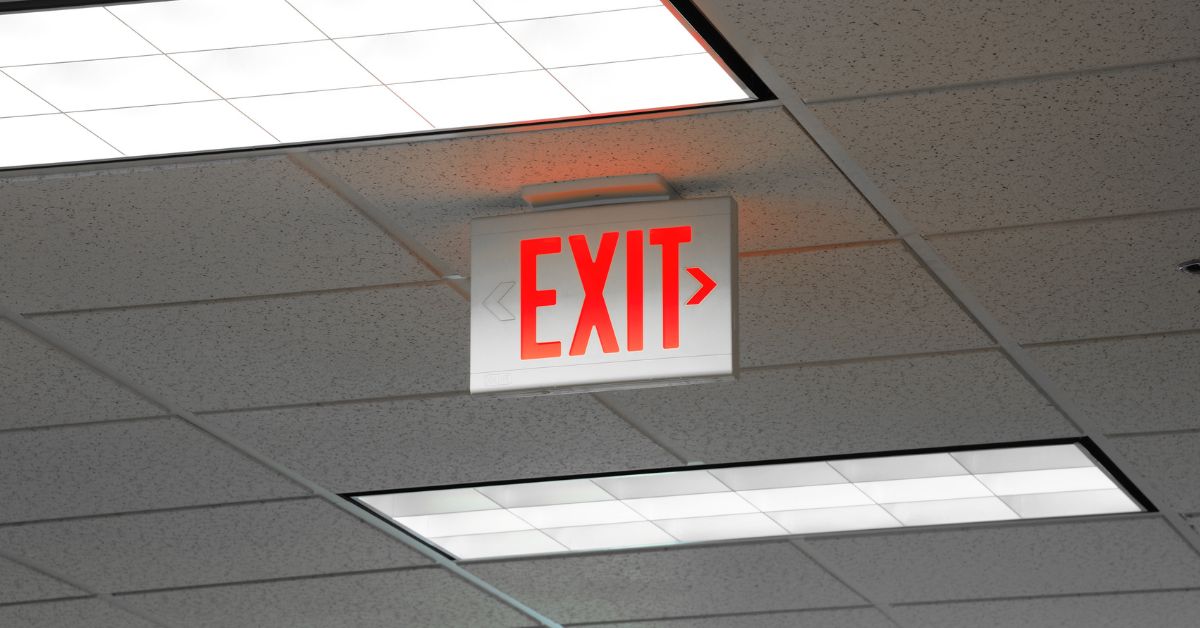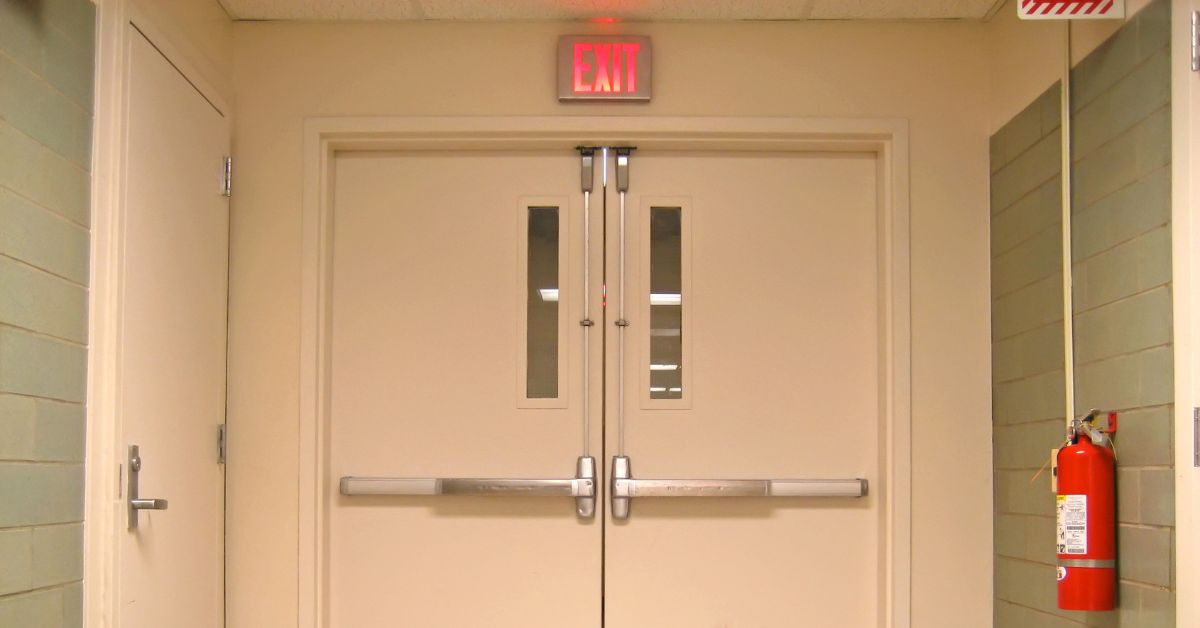A Complete Guide to Fire Codes for Emergency Exit Doors

Why Are Fire Codes for Emergency Exit Doors Important?
Exit doors play a key role during evacuations in emergency situations. Fire codes exist to make sure these doors are accessible, functional, and well-maintained to provide safe evacuation routes. Non-compliance with these codes can lead to significant consequences, including fines, lawsuits, and, most importantly, occupant safety risks.
You can reduce risks, avoid penalties, and create an overall safer environment by understanding and complying with fire codes.
Key Regulations for Emergency Exit Doors
Knowing the fire codes that apply to your emergency exit doors can help you stay compliant, so be aware of some important regulations.
1. Occupational Safety and Health Administration (OSHA) Standards
OSHA plays a significant role in emergency exit door compliance. Some of its key requirements include the following:
Clear Pathways and Doors
Exit doors must be free from obstructions. Furniture, boxes, and signage cannot block the pathway to or from the exit.
Illumination
All exit routes must be well-lit, including the pathway leading to the door and the door itself. Emergency lighting must quickly activate in the event of a power failure.
Exit Markings
You must have clearly marked exit signs that are visible from 100 feet away to properly guide occupants toward safety.

2. International Building Code (IBC) and International Fire Code (IFC) Requirements
Both the IBC and IFC define fire safety requirements for new constructions and renovations. Key points include the following:
Door Swing Direction
Exit doors must swing in the direction of travel if the room or area serves more than 50 people.
Width and Height
Doors must meet specific width and height requirements to accommodate the number of people expected to use them. Typically, these doors must be at least 32 inches wide and 80 inches high.
Latch and Lock Systems
Emergency exit doors cannot have locks or latches that require keys, tools, or special knowledge to operate during an evacuation. Many places require panic hardware.
3. Americans With Disabilities Act (ADA) Compliance
The ADA ensures exit doors are accessible to everyone, including individuals with disabilities. Some key ADA requirements include the following:
- Door handles, pulls, and latches must be easy to operate with one hand.
- Door thresholds must be beveled and cannot exceed half an inch in height to prevent obstacles.
- Braille and tactile signs must be present to assist visually impaired individuals.
4. National Fire Protection Association (NFPA) Standards
The NFPA sets forth guidelines in its NFPA 101 Life Safety Code, which covers exit door regulations, such as the following:
- Panic bars and crash hardware to allow for immediate egress of large groups of people, especially in hazardous areas.
- A fire-resistance rating suitable for their location. For example, stairwell doors must have a 90-minute fire rating.
Common Compliance Issues To Avoid
Understanding the codes is only half the battle. You must avoid common pitfalls to stay compliant and prioritize safety.
Obstructions
Make sure nothing blocks exit doors or pathways. Even temporary items, such as chairs or decorations, can cause significant risks during emergencies.
Non-functional Doors
Regularly inspect and test all exit device hardware to ensure the doors open and close properly. Faulty hinges or broken panic bars can lead to non-compliance.
Incorrect Signage
Missing or improperly placed exit signs can confuse occupants during emergencies. Illuminate the signs and ensure their visibility.
Improper Locking Mechanisms
Replace all locks that are not up to code and require keys or complicated procedures to open with compliant hardware.
Failure To Maintain Fire Ratings
Replacing or repairing fire-rated doors with non-rated materials can compromise their ability to withstand fire, leading to violations.
You can avoid disruptions to your operations and guarantee the safety of your occupants by addressing these common issues.

How To Stay Compliant With Fire Codes
You must stay ahead of fire code requirements to maintain a safe and operational property. Follow these best practices to remain compliant.
1. Conduct Regular Inspections
Establish a schedule to inspect your emergency exit doors and pathways. Look for signs of wear and tear and verify that all doors are functioning correctly.
2. Train Your Staff
Educate employees and contractors about the importance of fire codes and how to maintain compliance. Training should include proper usage of panic bars, keeping pathways clear, and reporting maintenance needs.
3. Work With Professionals
Hire experienced contractors or consultants when installing or upgrading emergency exit systems. These professionals will ensure your doors meet all legal requirements, including fire resistance ratings and ADA compliance.
4. Stay Updated on Regulations
Fire codes may change over time, so keep yourself informed of updates and new mandates by regularly consulting resources, such as OSHA, NFPA, and local building departments.
5. Plan for Emergencies
Include emergency exit procedures in your fire safety plan and conduct regular fire drills so occupants are familiar with exit routes and know how to safely evacuate.
6. Invest in Maintenance
Schedule routine maintenance checks to replace worn hardware, test panic bars, and verify door alignment. Well-maintained doors reduce the risk of malfunctions during emergencies.
Leveraging Professional Expertise for Compliance
Navigating the complexity of fire codes can feel overwhelming, especially for business owners and property managers juggling multiple responsibilities. Partnering with professionals who specialize in building safety and fire code compliance can make all the difference.
Fire safety consultants can assess your existing setup, recommend upgrades, and ensure every emergency exit door meets regulatory standards. Additionally, many contractors now offer packages that combine installation, maintenance, and training to make compliance as seamless as possible.
Create a Safer Environment Today
Though an important regulatory requirement, emergency exit doors are also life-saving tools that are vital for maintaining your occupants’ safety. Do your part to establish a safe, compliant, and well-equipped building with this complete guide to fire codes for emergency exit doors.
Don’t leave safety to chance—if you’re unsure whether your emergency exit doors are up to code, consult a fire safety expert today to conduct a thorough compliance review.

Author
Greg Richard
Chief Technical Officer and Founding Member of DoorHub.com